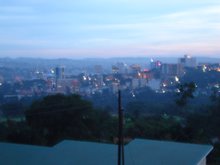The Citadel is massive. The most popular site inside of it seems to be the Mohammed Ali Mosque, a “newcomer” to Cairo, having only been built in the mid-19th century..

Because I was wearing short-sleeves and shorts, I had to wear a funny green cape to cover my arms and legs before entering the mosque, of which J had no end of fun taking pictures.

This is out in the courtyard of the mosque (I haven’t grown a humpback since moving to Africa; I’m also wearing a backpack under the cape.)

The clock tower was a gift from King Louis-Philippe of France in exchange for the obelisk in the Place de la Concorde in Paris and was damaged upon delivery and has never been fixed. Inside, the vast prayer hall:

From the Citadel’s walls, there are some amazing views over Cairo. In this picture, the pyramids are barely visible in the distance (though I’m not sure you’ll be able to see them in the reproduction).

We checked out the military museum, had a Coke at the café, and then called it a day for the Citadel. We walked back down to the street and found a cab and asked the driver to take us to the Khan, but since it was still only mid-morning, the driver told us the Khan would still be dead with everyone at services. So he took us to Coptic Cairo instead.
Coptic Cairo is the oldest part of the city, a compound lying within the walls of the 3rd-century AD Roman fortress of Babylon. Our guidebook dubs the Hanging Church the most beautiful of all Cairo’s churches. It is called a “hanging” church because it was built on top of the Water Gate of Babylon, possibly as early as the 4th century, though the original structure was destroyed in rebuilt in the 11th century.


For some reason, I was somewhat more enamored with the Convent of St. George, reached via an underground passageway, dating to the 15th-century.

We also visited the Ben Ezra Synagogue, the oldest synagogue in Egypt, and the Church of St. Barbara, both of which were sort of pushed upon us by a guard eager for a tip even though we were ready for lunch.
Our cab driver had waited for us outside the walled confines of the compound and now took us to Khan al-Khalili in heavy traffic (which he was not happy about). After getting directions from fifteen different people, we finally found the Naguib Mahfouz Café, named after the dude who won the Nobel Prize for Literature in 1988.

Khan al-Khalili is a massive bazaar selling everything imaginable. It’s difficult to capture what the Khan is really like in a photo—narrow passageways, hordes of people, constant haggling…

We planned on getting lost in the maze of the bazaar but didn’t last long before extracting ourselves from the fray and catching a cab back to the hotel. The cab driver we found didn’t speak English very well. We told the guy we’d give him 30 pounds. He didn’t understand. He asked for 20. We told him it was a deal.
Back at the hotel, we watched Quantum Leap on television and started an episode of Nash Bridges when the power went out. We sat in the dark for a few minutes—this had happened once before and the power had immediately come back on—but nothing happened. We became homesick for Uganda. J called down to the front desk.
This is what I heard:
“We were just wondering if the power was coming back on any time soon…The electricity? Is it coming back on?...We have no electricity in our room.”
Apparently they had no idea. We sat in the dark for another ten minutes and J called down again. The front desk told him someone was on the way. We sat in the dark for another five minutes, wondering desperately how Nash Bridges was going to catch that darn stalker and now we surely would never know. Just as J went out in the hallway to investigate, the power came back on.
We dressed for dinner and went out front to ask the doorman for a cab to La Bodega, what turned out to be a trendy restaurant in an old mansion. He told us it was close enough to walk and gave us directions. His directions involved getting to a certain street and then asking someone whether to go left or right. We got to the street and couldn’t find a single person who spoke English. Already the restaurant was turning out to be not five minutes away, as we were told, but a good solid twenty minutes on foot. We were tired even before we started walking and now late for our reservations. We chose right, which was of course the wrong way. We stopped at a little bodega on the side of the street (sadly not La Bodega) and again no one spoke English. Exasperated, J turned to me and exclaimed, “Why now of all times can we not find anyone who speaks English?” And a man passing by turned and said in an American accent, “I speak English.” Oh.
The restaurant was urban and modern and made us miss New York, but the food was really only average. Afterwards we stepped outside and decided we could swing the walk back to the hotel, now that we knew what we were in for. But we didn’t know what we were in for. We got lost. Zamalek is a lovely neighborhood to get lost in. There are a mess of embassies and other beautiful mansions, but after thirty minutes we were exhausted. It was the first time in my life I thought I might actually be able to fall asleep while walking. After two sets of bad directions we hopped in a cab. When we got back to the hotel, the same episode of Quantum Leap was being repeated on television.

No comments:
Post a Comment